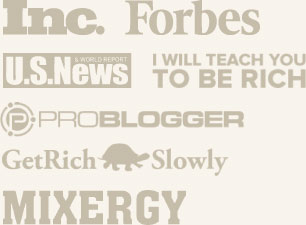When The Sh*t Hits the Fan With Your Startup
 Here’s the story of how our funded startup almost collapsed–how we recovered, and how ultimately we became better and stronger because of it.
Here’s the story of how our funded startup almost collapsed–how we recovered, and how ultimately we became better and stronger because of it.
It was January 2013 and we’d run into some issues scaling our business. We’d made design decisions on how we built our tool back in October 2010 that were starting to bite us hard as we tried to gain larger clients. Neither Parnell (my co-founder) and I had done anything wrong–we’d just originally built our software to serve the needs of an SEO consultant (me, back then!) and those decisions weren’t scaling to large agencies with tens or hundreds of users potentially using our software.
As more agencies trialed (and ultimately didn’t convert into paying customers) with our software, we uncovered so many fundamental flaws that we were forced to consider a complete re-write. I wanted to add recommendations. Our customers needed more agency features. The feature requests were piling up and the technical debt we had accumulated was staggering. The good news was that we’d uncovered a whopper of a market–the bad news was that our software, as currently written, wasn’t cutting it.
Frustrated by the technical debt and facing serious doubts about his ability as a technical co-founder, Parnell thought about leaving the company. At first I thought it might be a good idea, as well, as he didn’t want to face the prospect of re-writing everything, only to potentially fail again. But a couple days later, after I went through some deep thoughts, I gave him a very personal plea to stay. Next to Brian, my fiance, Parnell is my closest friend in the world, and I believed in him and his technical ability. (I mean, the dude codes Haskell for fun. 😉 ) I told Parnell I couldn’t imagine building this company without him.
Calling on Investors
We called in one of our closest investors for advice, and Parnell and our investor had a 1:1 meeting. Our investor, being the savvy guy he was, told Parnell it was ultimately his choice, and recommended Parnell take a short disconnect (a week or so) to address his burnout. Fortunately, our software, despite not being quite what agencies wanted, was making a fair amount of money and was running smoothly, so Parnell could disconnect without the whole company falling apart.
Parnell took a couple days off–not even a whole week–and came back in, rejuvenated. Then it was time for a series of meetings with customers, potential customers, and investors. What we found out really opened our eyes. We started getting testimonials like “Without your software, we would have had to hire two full-time people.” I started involving Parnell in the customer discussions–previously, we’d thought it better if he stayed focused on code, but now we both realized it was best for him to hear all the awesome stuff people were saying about our software.
Still, though, we knew we’d have to rewrite our software to survive. We also knew the funding we’d raised ($210,000, at that point) wasn’t going to be enough to see us through a rewrite.
The Part Where We Heard “No” A Lot
We opened up conversations with VCs as well. Even though we were nowhere near getting a series A, and despite all the technical debt, we figured Mark Suster’s “lines, not dots” applied here. We got a bunch of “no”s, and advice from one of our advisors that we’d need more revenue to start hearing “yes”es. ($80,000/mo of revenue and growing at a consistent clip is the number I’ve heard several times.) Fair enough–we hadn’t gone in expecting to secure a $1M investment; we just wanted to get on their radar, which we did. As we grow, I fully expect some of those “no”s to turn into “yes”es.
Stripping Everything Down to the Ground
We knew it would take months to rewrite the software, so we threw out all assumptions and started from scratch. I firmly believe no outside problem (running out of money; struggling to pay bills) can’t be fixed by looking inside yourself and becoming a better, stronger person.
I went through a deep meditative session one night and questioned everything. This was my life and I could do anything I wanted. I didn’t have to run a startup if I didn’t want to–although I’d definitely picked that path over the “grow a blog and write a book” option. (Nothing wrong with that option, by the way–I’m just such a startup junkie at heart that I really wanted to do a startup instead!)
I turned inward and asked myself: If I could do anything, what would I do?
And I found the answer: I’d run a startup. It just wouldn’t be what we’d built with Whoosh Traffic.
Smarter and with more experience under our belts, Parnell, Paul (our senior developer) and me could build anything.
Daring to Dream
In that meditative state, I dared to dream. When I was doing consulting, I kept hearing the same questions from my consulting clients: How do I get more traffic/conversions/sales?
What if we could build software that answered those questions? There were patterns in what I’d say to my clients. We could sniff that out and build software that acted as a “marketing consultant in a box.” And I could put my face on it and do the training videos I’d always wanted–except they would be interactive, based on the problems clients were actually experiencing.
Then I came back down to reality. Was this completely insane? How could I build what was basically an AI engine for website owners? Was this idea too big–too ridiculous?
Then back to my train of thought. 80% of websites have the same simple problems. If we solved those problems, we’d be heroes. And those problems weren’t hard to solve–if you’re a marketing expert. But when you’re just a website owner, and you’re not a marketing expert, it can seem impossible to crack the nut of getting more traffic and sales.
We did customer development. It was no joke–potential customers went nuts. I explained what was possible to do and the most consistent response I got was, “Can I try this out right now? I need this.”
We ran it past investors. More seed money came in. We closed another $175,000 in seed funding quickly. I had found something deep inside myself and I was driven, and I could see the faces change on potential investors as I showed them my vision of the future. I kept telling people the same thing: “This is a crazy big idea. If we can pull it off, we’ll change analytics forever.” I looked at myself in the mirror and told myself that if anyone was going to change the way we as a society thought about website analytics, why not me?
I knew I had to try. It was an alarmingly huge concept, but I had to do it. If we failed, it would be because some other company did it better. I could see the future with this sort of analytics software in it. I knew it would have to happen. If not us taking the lead, it would be another company. But we had (have!) a shot.
Techstars Austin
June rolled around. On June 21, I took a meeting with Jason Seats, the managing director of Techstars Austin. I thought I just wanted to be a mentor for this version of Techstars, but Jason convinced me to consider applying for the program. “Isn’t this for companies that are just getting started?” I asked him. We had cash, we had a product vision, and we were (finally) executing well.
Instead of trying to convince me himself, Jason did the smartest thing he could have possibly done: He introduced me to Mat Ellis, CEO of Cloudability, who had gone through the Techstars Cloud program in San Antonio with Jason previously. Mat was in a unique position: Cloudability had already raised $1M in a seed round with no cap before they had entered Techstars. Mat moved his schedule around, and we jumped on a call. We talked for 45 minutes and I asked Mat all my questions. Finally, at the end of the call, I hung up, excited. I was starting to figure out that in every Techstars class there are 1 or 2 companies that go on to become “home runs.” And I had a feeling we might very well be one of those companies.
Besides, where else are you going to take a huge freakin’ idea and get the best advice possible? For us, it was a decision between Techstars and Y Combinator. We weren’t opposed to Y Combinator (though I did tell one of their partners that YC felt like a frat house to me–I wasn’t sure as a 32-year-old female founder that I’d fit in there), but neither Parnell nor I really wanted to move to the Bay Area for 3 months. I’d already been in the Bay Area for 10 years, and I’d rather stay and build my company in Austin. Plus, we both really got a good vibe from Jason Seats. So Techstars it was.
Applying to an Accelerator
850 companies applied to Techstars Austin, and we were one of the 10 selected. If you’re considering applying for an accelerator, you should know the following. (Disclaimer: This is from my perspective as a Techstars participant, and is not official advice from their end.)
Each Techstars program is run by an individual (in our case, Jason Seats) hand-picked by the Techstars team. You’ll want to get to know the program director of the program you want to be in. For many teams, this may mean paying out of pocket to fly out and have an initial meeting.
Each program director is different, but I know Seats in particular is a huge “go by my gut” type of person. If you are confident, articulate, and you are “interesting” (hard to define, but you can probably picture the interesting people in your life) he’s more likely to pick you to join.
Most accelerators won’t pick based on an idea. They are betting on you, not your idea–Techstars is pretty clear that 30-50% or more of their teams will change their idea during the program. (For us, it was not really about changing our idea, but more about honing down the finer points of how we wanted to execute on this whopper of an idea.) So spend way more time focusing on why you are the right fit, and less time on why your idea is awesome.
If you have traction, that’s a huge plus. If your founding team has been working together for a while, that’s even better. If you think you don’t need a co-founder, may I humbly suggest you haven’t found the right person yet, and to keep looking? I thought I didn’t need a co-founder until I met Parnell. He’s great in every way that I’m not, and vice versa.
You don’t have to have raised funding to join Techstars–we had, but we’re the exception, not the rule.
If you’ve done something wild or out of the ordinary, make sure to mention that, too, especially if it qualifies as “interesting” (see above.)
If you’re the kind of person people naturally want to follow, you’re much more likely to get in to an accelerator. If you’re not sure what that means, you are probably not that type of person, but that doesn’t mean you can’t become one. Start a blog if you like to write; start a video series; write thoughtful comments online; run a class; post code snippets on Github; build some sort of successful business, even if it’s selling stuff door-to-door.
What About Giving Up Equity?
What about giving up 6% of your company? Is it worth it? I’m only three days into Techstars so far, but I’d already say “yes” to that. When you are at the point of considering an accelerator, 6% of your company is not worth that much (yet).
And now I’m going to let you in on what I think is one of the fundamental secrets of success in running a startup: Get as many smart people involved in helping you succeed as possible. That may mean bringing them on as investors, customers, or more. We’ve now taken investment from both 500 Startups (though I didn’t do their accelerator) and Techstars, in addition to many angel investors. That’s a whole lot of people who are financially interested in making sure we succeed.
The corollary to that is that when the sh*t inevitably hits the fan, as it will with any startup, that you not be afraid to get them involved then, as well. Every startup has nearly imploded. Many startups nearly implode several times before they finally make it. Your investors can only help if they know something is wrong, and they are there to help. So ask!
I’m really happy we’re in Techstars. I think we have a real shot at this. And if we do fail, I’ve already faced that and I’m okay with it. I have to try to change the world. Otherwise, I might as well write that book and go back to consulting or building a lifestyle business. (Which, again, there’s nothing wrong with–it just wasn’t a path I personally want to explore at this time.)
Startups aren’t for everyone, but if you have a fundamentally huge idea, and you’re gutsy enough to stare it in the face and move mountains to make it happen, you should consider building a startup. And–if you do want to run a startup–you owe it to yourself to give your startup the best shot at success. Fundamentally, that’s why I chose to do Techstars.
We’re now rebranding, relaunching, and making progress. We’re just about to change our name from Whoosh Traffic to MarketVibe. Though we’ll keep our SEO roots (and continue to offer our current product to customers), we are moving toward an even larger vision. For me, the huge shift came when I went within and asked myself what I really wanted to do–and started believing in myself and my ability to pull this off.
More to come as we go through Techstars–I plan to keep blogging on this, as there are precious few perspectives on accelerators out there. Enter your email address in the form below and I’ll keep you updated!
P.S. You may have noticed my recent absence from blogging, and that I didn’t launch my Art of Email course as expected last month. Now, you finally know what happened. 🙂


